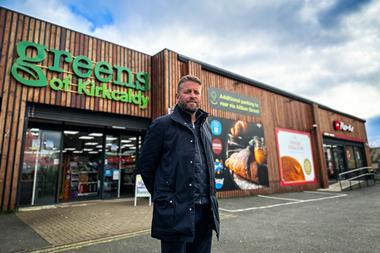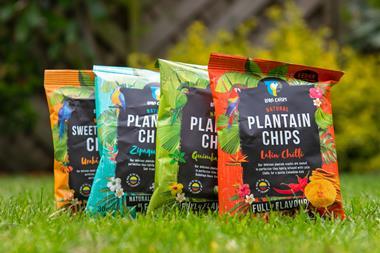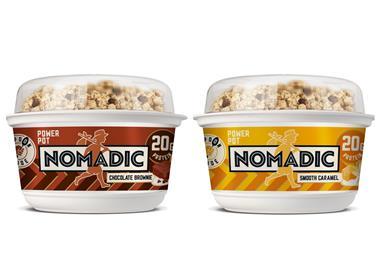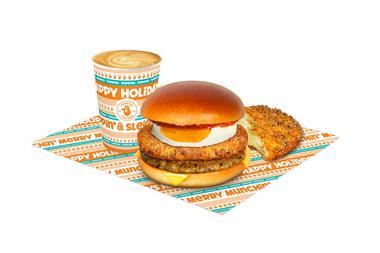Big brands need to be bolder with not just the aesthetics of packaging but also the functionality says Liz Hamson
The middle-aged woman with a family subconsciously laid some sliced pineapple out on a plate in exactly the same way it was presented in the pack.
However, she also did what most people do when confronted with a bagged salad -
immediately pulling the bag open without bothering to read the instructions. Again, the packaging was quickly discarded.
The challenge, says Gough, is to match the functionality of packaging to people’s needs and expectations while making it tactile and exciting to handle.
Functional packaging has played a major part in product innovation over the past year or so. Take Unilever’s SteamFresh range, the Rubicon sensory straw, and the self-heating Hotcan from the company of the same name.
But it’s not just the brands that are getting in on the act. As interest groups become increasingly outspoken in their criticism of packaging that is not user-friendly - jars that older customers struggle to open, for example - retailers, too, are taking the opportunity to reassess their packaging and ask whether they could be doing more to improve the functionality of their packaging.
M&S is a consortium member of Faraday Packaging, the R&D network run by Leeds, Sheffield and York universities. It allowed Katherine Gough, a Helen Hamlyn senior research associate at the Royal College of Art, into its stores to analyse how shoppers emotionally and physically interact with packaging.
With a remit to come up with ideas that make packaging easier to use, she took video footage of four shoppers of different ages and from different social and economic backgrounds as they spent £25 worth of vouchers in store.
She then videoed the four - a young professional, an empty-nester, a retired woman living alone and a mother with a young family - unpacking the goods at home as they were preparing their evening meals.
The research, which was carried out between October 2003 and October 2004, produced some fascinating insights into the way people shop, says Gough.
“The young professional woman was particularly interesting,” she says.
“She would round the store twice, once to look at the items and then once to select them. Asked what she was looking for, she said the colour and the date.
“But when I looked at the video footage again, I noticed that she was actually picking up and smelling the packaging. She did it with the strawberries and the meat. It poses the question: how is packaging enhancing the ability of the consumer to choose food?”
The young woman was looking for packaging cues to freshness and authenticity and although she claimed that she only sometimes bought bagged salads, she admitted she would often buy something if it looked nice, showing how packaging can overcome preconceived perceptions.
The empty-nester demonstrated a rather more prosaic approach towards the shopping element of the task. But at home, her behaviour also provided some interesting insights.
Almost the first thing she did was unpack the goods and decant them into plastic containers in the same way someone might with deli items.
Pointing to the way she dealt with a packet of ham, Gough is blunt: “That’s the brand in the bin now. The ham packaging is non-resealable and to her dispensible. Her perception is that it is valueless.”
This lack of understanding of how consumers really use and understand packaging is reinforced by the way the retired lady dealt with a six-pack of cakes.
She removed the plastic packaging from the cardboard box, cut it open, put several cakes on a plate, which she then covered in plastic film, and then put the remaining cakes back in the pack, scrunching the film at the end to try and preserve freshness.
In this case, says Gough, a simple seal would have provided genuine protection.
The research also highlighted aspects of packaging that do work.
Shoppers who had bought a prepared salad in a hard plastic tub container tended to retain the tub because of its greater perceived functionality.
As part of her research, she designed two types of user-friendly packaging, one for pre-packed courgettes and one for prepared salad.
“When people bought pre-packed vegetables, they almost always sliced the packaging open with a knife. That can obviously be dangerous,” she observes. She came up with a design featuring a recess around the edge of the pack that the consumer can pull and rip the plastic covering from.
For salads, she designed a semi-rigid pack that featured perpendicular seals that would not only retain its original shape but be resealable - and hence more functional.
M&S has no plans to develop the packaging concepts; they were intended only to illustrate ways in which the research could be used to develop more user-friendly packaging.
Gough has, however, developed a tool that she believes will help retailers and manufacturers alike more accurately assess consumer perceptions by asking how they shop and select, open and access, store and decant, prepare and consumer and dispose and recycle products.
The idea is that, by asking these questions, they develop a more holistic understanding of how consumers interact with packaging. Only then, she says, will they really be able to optimise the functionality - and the aesthetics - of their packaging.
As the M&S research project demonstrates, the answers are not always as straightforward as the usual quantitative research might suggest.
The middle-aged woman with a family subconsciously laid some sliced pineapple out on a plate in exactly the same way it was presented in the pack.
However, she also did what most people do when confronted with a bagged salad -
immediately pulling the bag open without bothering to read the instructions. Again, the packaging was quickly discarded.
The challenge, says Gough, is to match the functionality of packaging to people’s needs and expectations while making it tactile and exciting to handle.
Functional packaging has played a major part in product innovation over the past year or so. Take Unilever’s SteamFresh range, the Rubicon sensory straw, and the self-heating Hotcan from the company of the same name.
But it’s not just the brands that are getting in on the act. As interest groups become increasingly outspoken in their criticism of packaging that is not user-friendly - jars that older customers struggle to open, for example - retailers, too, are taking the opportunity to reassess their packaging and ask whether they could be doing more to improve the functionality of their packaging.
M&S is a consortium member of Faraday Packaging, the R&D network run by Leeds, Sheffield and York universities. It allowed Katherine Gough, a Helen Hamlyn senior research associate at the Royal College of Art, into its stores to analyse how shoppers emotionally and physically interact with packaging.
With a remit to come up with ideas that make packaging easier to use, she took video footage of four shoppers of different ages and from different social and economic backgrounds as they spent £25 worth of vouchers in store.
She then videoed the four - a young professional, an empty-nester, a retired woman living alone and a mother with a young family - unpacking the goods at home as they were preparing their evening meals.
The research, which was carried out between October 2003 and October 2004, produced some fascinating insights into the way people shop, says Gough.
“The young professional woman was particularly interesting,” she says.
“She would round the store twice, once to look at the items and then once to select them. Asked what she was looking for, she said the colour and the date.
“But when I looked at the video footage again, I noticed that she was actually picking up and smelling the packaging. She did it with the strawberries and the meat. It poses the question: how is packaging enhancing the ability of the consumer to choose food?”
The young woman was looking for packaging cues to freshness and authenticity and although she claimed that she only sometimes bought bagged salads, she admitted she would often buy something if it looked nice, showing how packaging can overcome preconceived perceptions.
The empty-nester demonstrated a rather more prosaic approach towards the shopping element of the task. But at home, her behaviour also provided some interesting insights.
Almost the first thing she did was unpack the goods and decant them into plastic containers in the same way someone might with deli items.
Pointing to the way she dealt with a packet of ham, Gough is blunt: “That’s the brand in the bin now. The ham packaging is non-resealable and to her dispensible. Her perception is that it is valueless.”
This lack of understanding of how consumers really use and understand packaging is reinforced by the way the retired lady dealt with a six-pack of cakes.
She removed the plastic packaging from the cardboard box, cut it open, put several cakes on a plate, which she then covered in plastic film, and then put the remaining cakes back in the pack, scrunching the film at the end to try and preserve freshness.
In this case, says Gough, a simple seal would have provided genuine protection.
The research also highlighted aspects of packaging that do work.
Shoppers who had bought a prepared salad in a hard plastic tub container tended to retain the tub because of its greater perceived functionality.
As part of her research, she designed two types of user-friendly packaging, one for pre-packed courgettes and one for prepared salad.
“When people bought pre-packed vegetables, they almost always sliced the packaging open with a knife. That can obviously be dangerous,” she observes. She came up with a design featuring a recess around the edge of the pack that the consumer can pull and rip the plastic covering from.
For salads, she designed a semi-rigid pack that featured perpendicular seals that would not only retain its original shape but be resealable - and hence more functional.
M&S has no plans to develop the packaging concepts; they were intended only to illustrate ways in which the research could be used to develop more user-friendly packaging.
Gough has, however, developed a tool that she believes will help retailers and manufacturers alike more accurately assess consumer perceptions by asking how they shop and select, open and access, store and decant, prepare and consumer and dispose and recycle products.
The idea is that, by asking these questions, they develop a more holistic understanding of how consumers interact with packaging. Only then, she says, will they really be able to optimise the functionality - and the aesthetics - of their packaging.
As the M&S research project demonstrates, the answers are not always as straightforward as the usual quantitative research might suggest.



















No comments yet